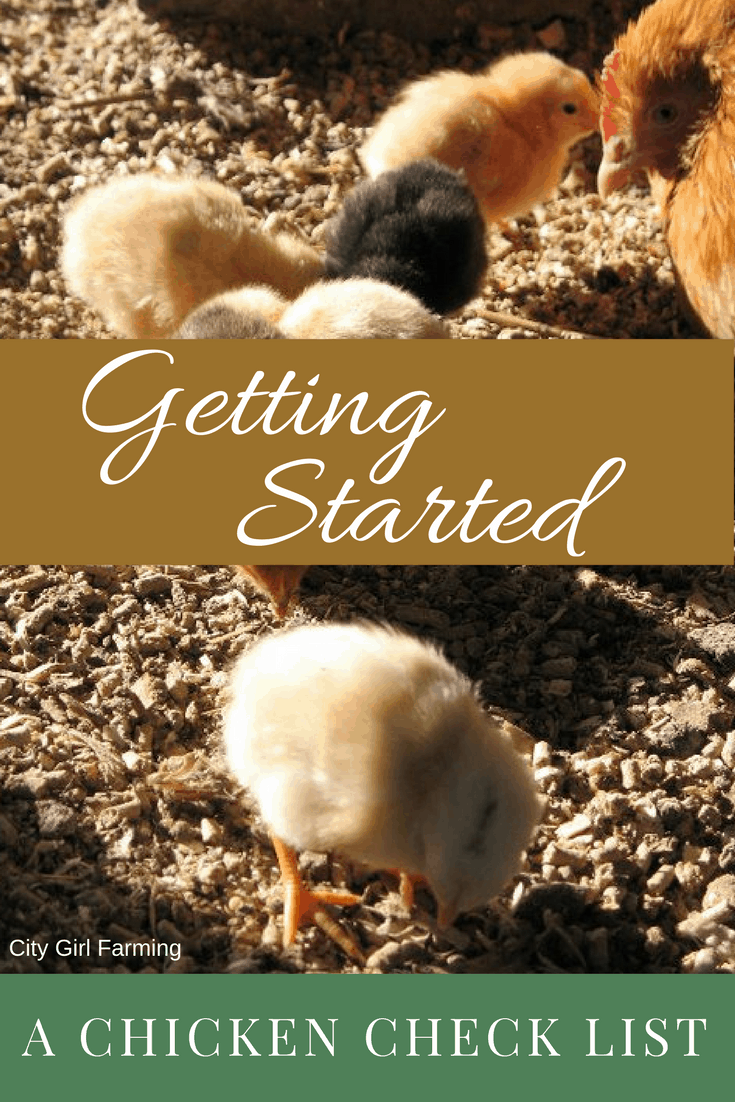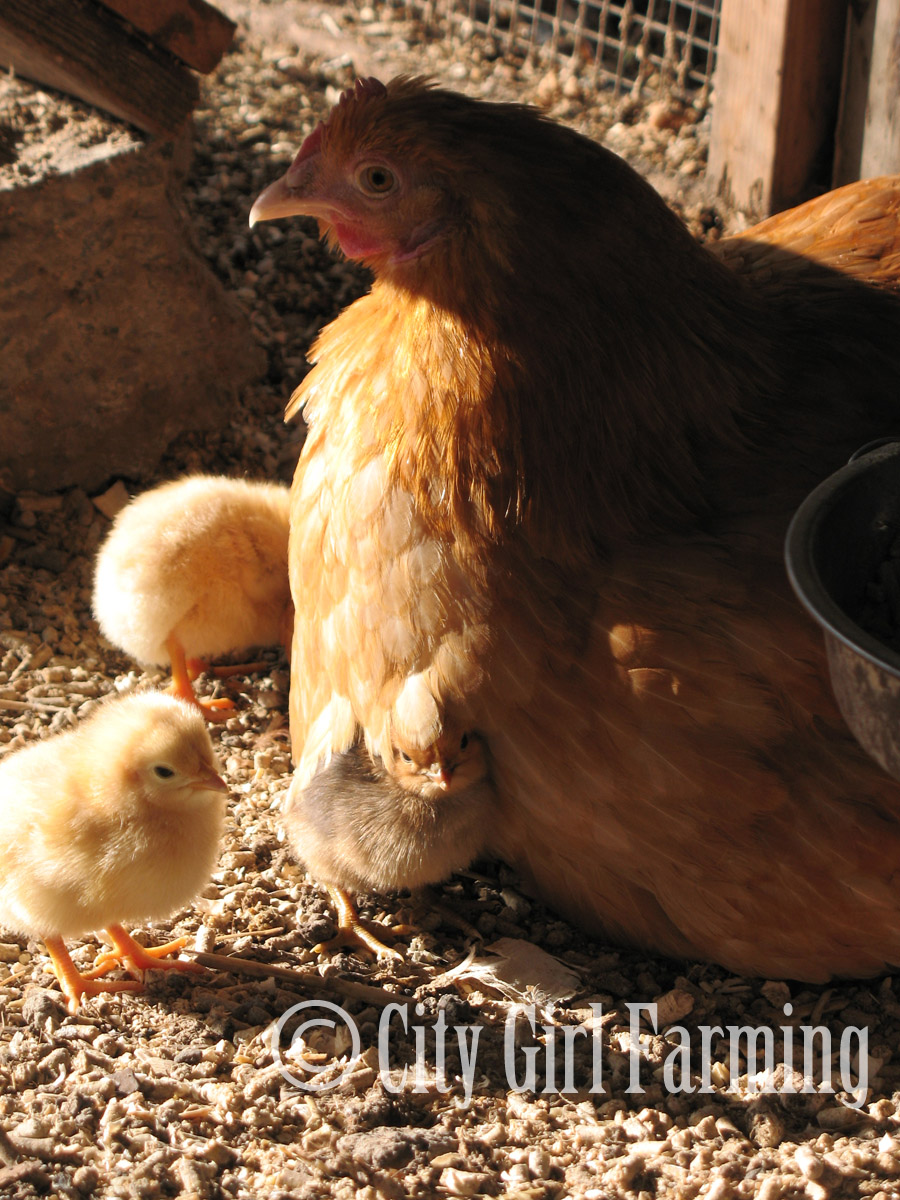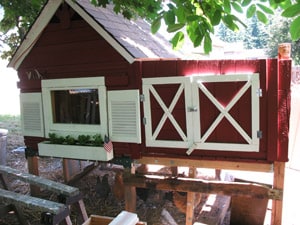Ready to get started with chickens but not sure where to start? Here’s a helpful chick check list to make sure you’ve got all your duck, uh, em, CHICKENS in a row before you take the plunge into backyard chicken ownership!

If you haven’t already gotten started with chickens yet, let me warn you: They are addictive! You’ll never be the same.
Before I dove in, I was a bit nervous. It’s one thing to grow up in the country and have chickens where my parents kept things running smoothly and I just had to scoop poo from time to time, but it’s totally different to be in charge of them without any adult experience (or so I thought). Back in the day, chickens were considered a food source. They weren’t named (well, except Phyllis Diller, a Polish with wild feathers sticking up on top her head). They weren’t pets. And I wasn’t solely responsible for them.
Yet, as an adult living in the city, I wanted more control over my food, even if just a little. I didn’t see my city chickens (i.e.: pets with names and personalities) as a complete food source themselves, but I did see them as a way to have fresh eggs delivered daily from the back yard.

And, I have to say bringing home those first cute chicks was one of the best decisions I’ve made as an adult. I love ‘my girls’ and what they’ve brought to my life—which is much more than free-range eggs I expected (which would have been enough).
A CHICK CHECK LIST:
Spring is the kick off of chick season. If you’re thinking about getting started with chickens this year (or sometime in the future), here are some things to consider, research, collect, and even (possibly) build to help make your chicken keeping experience positive from the start.
Check to Make Sure You Can Have Chickens Where You Live
While chickens have become more popular, there are still areas that don’t allow them. Make sure to check with your local city, town and county ordinances. If you live in the city, there will most likely be limits on the number of hens you can have (typically in the 3-5 range) and most won’t allow roosters at all (you don’t need them for egg production, which is good).
If your area allows chickens, but you live in an H.O.A, check with them too. There might also be guidelines about where your coop can be placed (if you’re in the city or suburb) in relation to your house, the neighbors, the front sidewalk, etc. Doing a little research up front can save you potential problems later on.

Learn About Chickens
Learn about chicken care as well as chicken breeds. There are over 250 kinds of chickens with unique characteristics. Decide which of those characteristics are most important. For some people, it’s important to have docile birds because they have children or grandchildren. For others, the whole point of chickens is the eggs, so good egg layers are most important? Others love collecting different colored eggs (white, light brown, speckled, dark brown, green, blue, etc) and look for breeds that specifically lay the colors they’re seeking. You can see my favorites lists here, and the reasons why, and how to pick the best ones for your situation.
Talk to people that already own chickens. Ask them questions. Find out the good and bad from a real live person who is raising chickens. They won’t gloss it over for you.
Take classes, if you can. Often local feed stores or even nurseries will hold backyard chicken classes for a nominal fee (and sometimes for free). The nice thing about a local class is that you can get pointed in the right direction for supplies (like the best place to buy chicks or feed, etc.) and they will probably already know local laws regarding chicken keeping in your area.
And don’t forget online chicken information. You can start here, with the chicken section on this site, or visit our sister site, City Girl Chickens. And Backyard Chicken has a great forum to ask questions and interact with other chicken owners.
Find a Place to Buy
Once you’ve learned about chickens and still want them, and after you’ve chosen your breeds of chickens you’d like, it’s time to find out where you can get them. With the rise in chicken popularity, you have a good chance to get at least some of what you want locally, but if not, there are several mail-order chick companies (like My Pet Chicken) that can send them to you (fresh hatched chicks don’t need to eat or drink for a couple of days because they’re still living off the yolk they just hatched from. Hatched chicks are shipped off quickly before the food and drink issue becomes a problem and you will usually have to arrive at the post office to pick them up.)
With over 250 different kinds of chickens to choose from, you might not be able to find every single breed of chicken you’d like to have. Some might be rare or endangered. Or not as popular in the country/region you live in. It’s always good to have backups on your list, if picking the breed is important to you.

Do You Need a Brooder?
If you want to start with chicks, you’ll need a brooder. This is a ‘chick nursery’ of sorts: a place to keep baby chicks warm and safe during the first few weeks of their life. A brooder will be equiped with a heat lamp to help them stay at the right temperature until they grow out of their fluff and into some feathers (they can’t regulate their body temperature until they have feathers). Set a brooder up before you bring your chicks home. Here’s information on how to set up a brooder. It’s not hard and doesn’t need to cost a ton. I often use a free appliance box from a local home improvement store where I can add a heat lamp and a tiny roost (it will take them a little while before they can balance on a roost, but it’s good practice and once they can, they love it).
Do You Need a Coop?
If you don’t have a coop, build or buy one BEFORE you bring chicks home—even BEFORE you go look at those cute fluffy things that you won’t be able to resist. Trust me on this one. The 6-8 weeks the babies need to stay in a warm, protected environment flies by at crazy speed and before you know it you’ll have a flock of chickens, ahem, with no place to live. Like I said, trust me on this one. Here’s my coop-building story (learn from my mistakes!!). And here are a few coops to fuel your inspiration.
A coop doesn’t have to be work of art (although some are). It has to adequately house (and keep safe) the number of chickens you’ll be keeping. If you’re thinking about building your own coop, here are some basics to cover when you do.
This is a great resource for those of you looking to build your own coop–there’s over 40 FREE plans for different coops–there’s a search feature that allows you to narrow down the results by the size, cost and difficulty. And FREE is a very good price. Go check it out over at The Happy Chicken Coop.

Feed and Water
If you’re bringing home chicks, their food will be different from an older hen. For chicks the feed is known as ‘chick starter’. You can choose from medicated or non-medicated (here’s how to choose which is best for you). When you pick up your feed, grab a chick feed container. There are a couple different kinds and both are super inexpensive.
You also might need grit for chicks. Grit is little ground up rocks that chickens eat to help them digest their food (they don’t have teeth to help them chew). It’s important that they have access to grit (if the chick starter doesn’t contain it) to help prevent a crop plug up (the crop is where the food goes after the bird swallows it. The grit helps grind the food down in the crop–think of the crop as a first stomach of sorts). They will be able to tell you at the feed store if you need to add grit or not.
As for water, it’s good to start with the smaller, quart-sized waterers for the little birds, so they don’t accidentally drown in too much water.

Bedding:
Bedding will need line the bottom of the brooder (as well as the coop once the flock moves out there). Some people, for the first few days, use paper towels or puppy pee pee pads. When the chicks are very young, they might eat or inhale pine shavings, so staying away from the shavings for a few days is a safer thing to do. Having said that, however, I have always used pine shavings without any problem. Other options for the brooder include old rags or anything that is absorbent, non-toxic and isn’t slick (and also doesn’t get slick when it’s wet).
Really, you can use just about anything, EXCEPT for newspaper or things that get slick. Slick surfaces can cause spraddle leg where the chicks legs go to either side (think of doing the splits) and can’t support her body or allow her to stand.
It might feel like a LOT to think about and learn about, but it’s not really that bad. And chances are, if you’re like most people who dive into backyard chicken keeping, you’re gonna LOVE it. And before too long, it will all be second nature.
A Few More Resources:
Okay, this isn’t officially part of a chick check list, but I wanted to leave you with couple of books you might enjoy and find helpful:
Raising Chickens For Dummies
by Kimberly Willis and Rob Ludlow
This is a great guide for anyone wanting to get into chickens. It’s pretty comprehensive and easy to read. This book does a good job at covering all the bases in chicken raising. Because of that, it’s my favorite go-to chicken resource.
Chicken Coops: 45 Building Plans for Housing Your Flock
by Judy Pangman
This book is a WONDERFUL resource for gleaning ideas in making your own backyard coop. There’s many great coops in the book with pictures and plans to get your juices flowing.
Since becoming a chicken owner, I haven’t ever had a single regret. Aside maybe waiting so long to do it. And because of that, I’ve become a chicken ‘pusher’…I think everyone should enjoy the benefits of owning chickens! It would make the world a happier place. 
